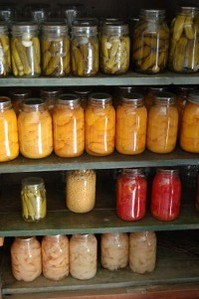How Canning Works – Learn The Basic Process Before You Begin
The canning world has seen little change since Nicholas Appert won the food preserving challenge put forth by Napolean Bonapart back in the early 1800s. Basically, you seal the containers, heat up the inside and when cooled, form a vacuum seal on the jar.
Now, there are a few different ways to can, as well as different requirements for canning certain items. So, before you get your canning equipment ready, there are things to know that will increase the likelihood for a successful outcome.
Let’s take a look at the process of canning and how canning works.
There are two main types of canning; boiling water and pressure. Different types of foods, based on their pH, their acid level, require a specific type of canning process. For instance, high acid foods like pickles work just fine in a boiling water canning process, while low acid foods like meats and most tomato products absolutely must be pressure canned.
There are four main parts to canning; the jar, lid, ring, and heating device. Of course, there are other tools that make canning easier, but let’s focus on the basics first.
For home canning, glass jars are the most popular choice. Canning in the industrial setting uses the steel alloy cans you see on your supermarket shelves. Glass jars made specifically for canning at home will withstand heat and pressure and, if thoroughly cleaned, can be reused every year.
Lids, the flat part that seals the contents of the jar, cannot be reused because once they are sealed, the gasket begins to wear down. Also, you will very often use a can opener to pry up a sealed lid, making a little dent in the lid. That dent means the lid will never seal another jar properly. This is an investment that you will make each time you start canning.
The ring holds the lid on during the heating process, keeping the lid from popping up, allowing water or steam to invade the contents of the jar.
The heating device is a large pot with a lid and a basket designed for holding the jars. This device is either meant to hold boiling water or it’s a pressure canner. Keep in mind that each heating device is made for specific foods. Also keep in mind that a pressure cooker is NOT a pressure canner and should not be confused.
Heating Process
The heating process is the most crucial part of canning. Once the jars are filled and lids and rings placed tightly on, the jars are placed in the heating device. As the heating begins, the foods in the jars begin to expand and vent a bit of air out of the jars. Keep in mind that if the rings are too tight, air can’t escape during heating; if rings are too loose, actual liquid may escape from the jars. Always follow manufacturer’s instructions on the lid and ring boxes.
Different foods require different amounts of heating and time. It’s important to follow canning recipes and instructions to the letter. Making sure you heat for the required time ensures that mold, yeasts, bacteria and any harmful enzymes that may be hanging around are destroyed.
Cooling Process
Once the jars are removed from the canning device, they begin to cool and the steam condenses back into water. Since there is now less air in the jar, a vacuum is created, pulling the lid down onto the jar. After the product has been cooled, the ring can be removed and the vacuum seal will still hold.
It is important to allow the items to cool thoroughly before you remove the rings to ensure a proper seal. Also, once cool, it is imperative to check the lids to make sure the seal took and there are no openings in the top of the jar. If there is a leak, be sure to consult your canning manual for what to do with the canned goods. Depending on the foods you canned, you may be able to reprocess, however many recipes will require you store the unsealed contents in the refrigerator and eat within a few days.
Knowledge is Power
Knowing how canning works allows us to make sure we have the best outcome in our canning process. It gives us a way to understand if everything worked the way it should have. Make sure you have all the needed items before you begin canning to ensure a great experience, then go pick out some fresh produce and start canning!
For more canning tips and lots of canning recipes, I recommend you grab a copy of my ebook Canning Made Simple.
Inside you’ll find over 40 canning recipes to get you started, along with simple to understand explanations about what to can, how to can, and even why to consider canning at all!
To support the blog, check out the HBHW eBooks available on Amazon. Thank you!
Disclosure: Some of the links below are affilate links, meaning, at no additional cost to you, I will earn a commission if you click through and make a purchase.


